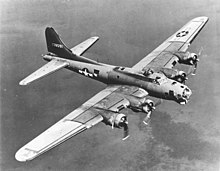Horizontal bomber
Horizontal bombers are bombing planes , which serve to ground targets with bombs to attack.
Differentiation from dive bombers
In contrast to dive bombers , horizontal bombers are those bombers that do not leave their flight altitude while the bomb load is being released. A horizontal bomber can take a larger bomb load, since the load on the airframe is not as high in level flight as in a dive. However, especially in the early days of military aviation, these machines were at a disadvantage when a target was to be hit with pinpoint accuracy, since such an undertaking was more difficult to carry out with target devices at that time than an attack with a dive bomber. For example, in an attack by American horizontal bombers on ball-bearing factories in Schweinfurt in October 1943, only about 10% of the bombs dropped landed less than 500 feet (about 150 meters) from the target, even though the machines were equipped with the then ultra-modern Norden bomb sighting device.
Horizontal bombers were therefore used more for area bombing, while dive bombers had individual objects as targets because of their greater accuracy.
An aircraft designed as a horizontal bomber was, for example, the Russian Tupolev Tu-58 , which was built as a prototype in 1941. The subsequent Tupolev prototype already combined the capabilities of the horizontal and dive bomber.
The horizontal bombers were often used as an alternative to torpedo bombers (e.g. Nakajima B5N ).
Horizontal bombers equipped with precision-guided ammunition can also hit their targets very precisely, so that the development of special dive bombers became superfluous.
literature
- Flying and Popular Aviation, January 1941, p. 16 [2]
Individual evidence
- ^ Oakland Aviation Museum: North Bombsight , accessed November 23, 2017
- ↑ Peter C. Smith: Dive Bomber !: Aircraft, Technology, and Tactics in World War II , s. 76 [1]

